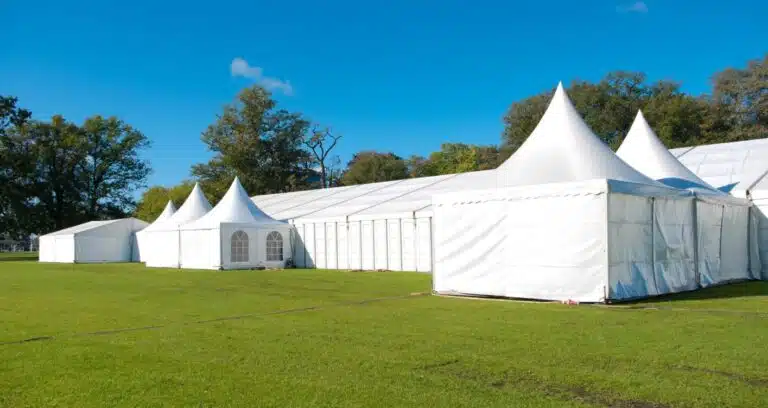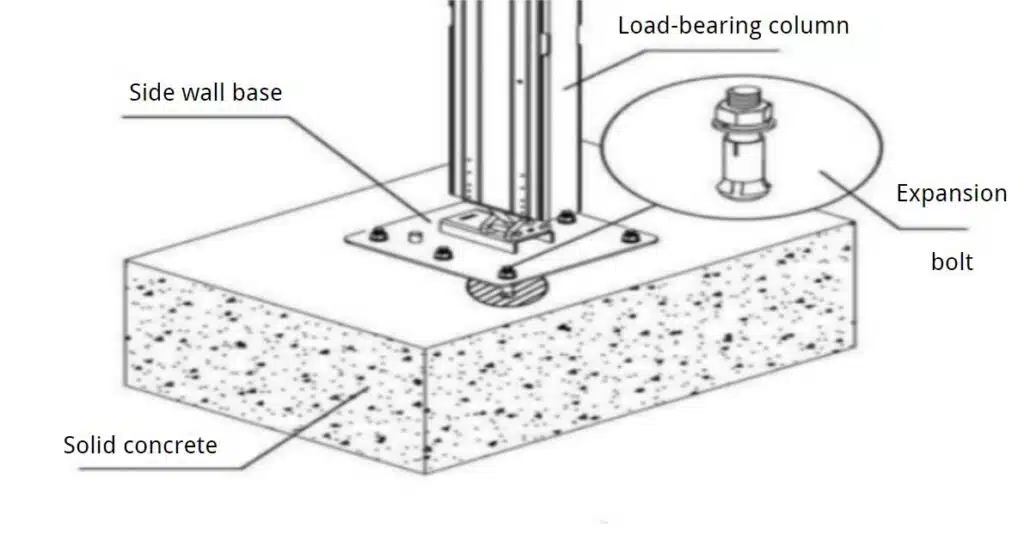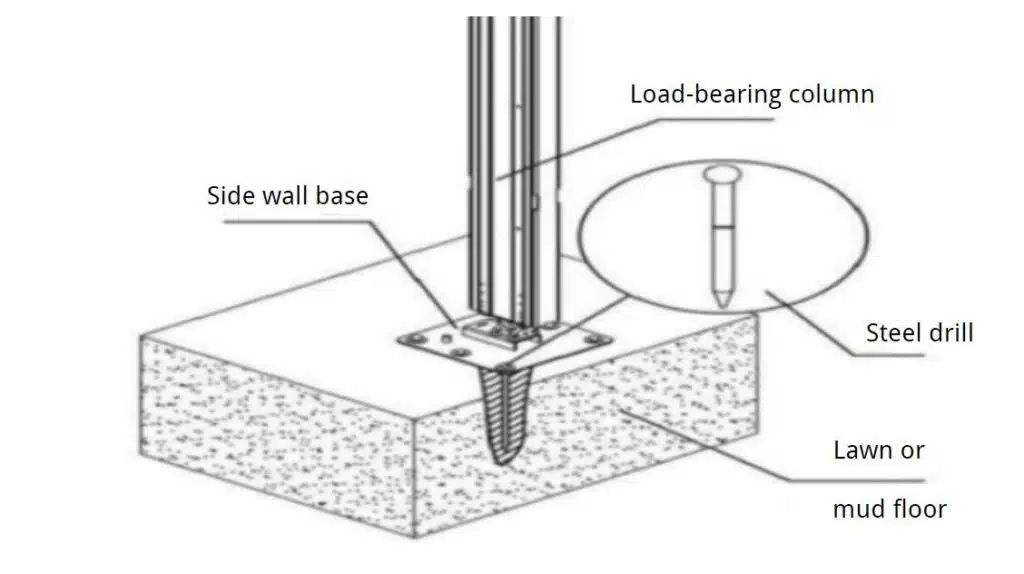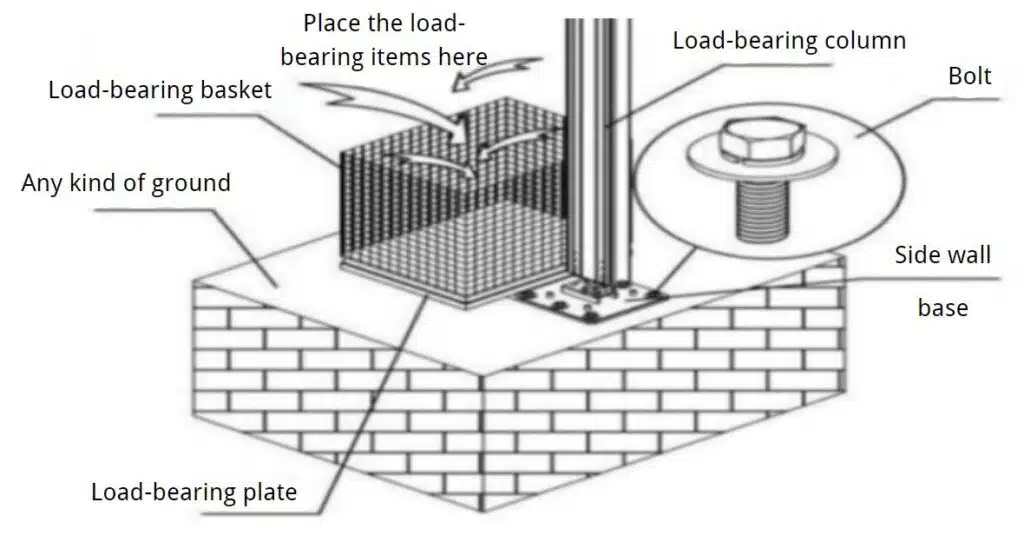Worried about your event tent flying away? Securing a tent correctly is crucial for safety and stability. I understand your concern about keeping things firmly on the ground.
Securing a tent depends on the ground type and how long you plan to use it. Common methods include ballast weights for temporary setups on hard surfaces, steel stakes for soft ground, and expansion bolts or reinforced concrete for more permanent solutions, ensuring your tent stays put.
When I help clients with their tent setups, I always emphasize that there is a perfect fixing method for every ground condition. We make sure the tent is safe and sound.
How to Set a Tent on Concrete Floor? (Temporary Plan)
Do you need to set up a tent temporarily on concrete without causing damage? Many of my clients face this issue when hosting events in urban areas or parking lots.
For temporary tent setups on non-damagable hard surfaces like concrete, asphalt, or tiles, ballast weights are the most common and effective solution. This method prevents any damage to the ground.
I often recommend ballast weight fixing1 for temporary events because it is very flexible. We use heavy objects to keep the tent in place. We generally use concrete blocks2 or large sandbags. We place them around the tent’s base. Sometimes, we even add special covers to make the ballast weights look better. This makes sure the event space looks professional. This method works well for trade shows, outdoor exhibits, or quick promotional events. We can easily set up and take down the tent without leaving any marks on the ground. This is a big plus for many event planners. They want to protect the venue’s surface. Ballast weights provide the necessary stability against wind and other forces. They do not require drilling or digging. This makes setup faster. It also lowers the risk of damaging underground utilities.
| Ballast Type | Ground Suitability | Pros | Cons |
|---|---|---|---|
| Concrete Blocks | Concrete, Asphalt | Very heavy, stable, reusable | Can be bulky, requires lifting equipment |
| Water Barrels | Any hard surface | Adjustable weight, easy to transport empty | Prone to leaks, less stable |
| Sandbags | Any hard surface | Flexible, easy to move, affordable | Can be messy, less weight per unit |
| Custom Ballast | Any hard surface | Aesthetic, integrated look | Higher cost, specific design needed |
How to Set a Tent on Lawn or Mud? (All Soft Base Surfaces)
What is the best way to secure a tent on soft ground like grass or mud? This is a common question, especially for outdoor festivals and sports events.
When setting up tents on soft ground like grass, dirt, or mud, steel stake ground fixing is the most reliable method. The stakes are driven deep into the ground for strong anchorage.
When I work on projects in fields or parks, I always turn to steel stakes. They are perfect for soft ground. We drive long steel stakes, typically 0.8 to 1 meter long, right through the tent’s footplates. We use a sledgehammer3 or a special machine to drive them deep into the ground. This creates a very strong hold. This method is very effective for large-scale festivals, sports competitions, or any event on natural terrain. The stakes go deep enough to resist strong winds. They also prevent the tent from shifting. It is a secure way to make sure the structure stays put. This is vital for the safety of everyone inside. It is also important for the tent’s integrity4. We always check the ground first. We make sure there are no underground pipes or cables before we start driving stakes. Safety is always my first concern.
How to Set a Tent With No Damage to the Ground?
Do you need to set up a tent without leaving any marks on the ground? Many venues have strict rules about preserving their surfaces.
When ground preservation is a priority, temporary fixing methods like ballast weights are ideal. They secure the tent effectively without altering or damaging the underlying surface.
I have had many clients who need to protect the ground. They hold events in historic parks or on expensive paved areas. In these cases, ballast weight fixing5 is my go-to solution. This method uses heavy weights placed on the tent’s footplates6. It keeps the structure secure without needing to drill or dig into the ground. We use concrete blocks, water barrels, or sandbags. These are placed strategically around the tent’s perimeter. This provides the necessary stability. The great thing about this method is that it leaves no trace once the tent is removed7. The ground remains exactly as it was before the setup. This is perfect for short-term events where ground alteration is not allowed. It also works well for areas that cannot be permanently changed. We make sure the weights are sufficient for the expected weather conditions. We always prioritize safety. We also prioritize protecting the venue.
How to Set a Tent on Concrete Floor? (Permanent Plan)
What is the best way to permanently secure a tent on a concrete floor? Sometimes, a temporary structure needs to become a long-term solution.
For permanent tent installations on concrete, expansion bolt fixing or reinforced concrete pre-embedding are the most robust methods. These provide superior stability and wind resistance for long-term use.
For long-term tent installations on concrete, I often use expansion bolts8. This method involves drilling holes into the concrete. Then, we insert and tighten expansion bolts through the tent’s footplates. This creates a very strong connection to the ground. For safety, the concrete needs to be at least 15 centimeters thick. This ensures a secure hold. This method is great for storage tents or industrial shelters. These tents need to withstand harsh weather for years. Another very strong option for long-term use is reinforced concrete pre-embedding9. Here, we embed steel plates into a concrete foundation. Then, we weld the tent’s footplates directly to these embedded plates. This method provides maximum stability and wind resistance. While it does damage the ground, it is ideal for truly permanent structures. It offers unparalleled security. It ensures the tent can stand strong for decades.
| Fixing Method | Ground Type | Duration | Ground Impact | Advantages | Disadvantages |
|---|---|---|---|---|---|
| Ballast Weight Fixing | Hard Surfaces | Temporary | None | No ground damage, flexible, reusable | Can be bulky, less wind resistance for extreme conditions |
| Steel Stake Ground Fixing | Soft Surfaces | Temporary | Minimal | Strong hold on soft ground, cost-effective | Damages ground, not for hard surfaces |
| Expansion Bolt Fixing | Hardened Surfaces | Temporary/Permanent | Holes drilled | Very strong, good for concrete, flexible for use | Requires concrete thickness, ground damage |
| Reinforced Concrete Pre-embedding | Any (with concrete base) | Permanent | Significant | Maximum stability, highest wind resistance | Major ground alteration, permanent damage |
Conclusion
Securing your tent correctly is key to safety and success. By choosing the right fixing method for your ground and usage, you ensure a stable and reliable structure.
-
Explore this link to understand how ballast weight fixing enhances event stability and aesthetics, ensuring a professional setup. ↩
-
Learn about the benefits of using concrete blocks for ballast, including stability and reusability, which are crucial for event planners. ↩
-
Learn the best techniques for using a sledgehammer effectively to ensure secure tent anchoring. ↩
-
Discover why ensuring a tent’s integrity is crucial for safety and performance at outdoor events. ↩
-
Explore this link to understand how ballast weight fixing can secure tents without damaging the ground, ideal for historic parks and paved areas. ↩
-
Learn how using heavy weights on tent footplates can provide stability and safety for outdoor events, ensuring a secure setup. ↩
-
Discover the importance of leaving no trace after tent removal, especially in sensitive environments like historic parks and paved areas. ↩
-
Explore this link to understand how expansion bolts can enhance the stability and safety of your tent installations. ↩
-
Learn about reinforced concrete pre-embedding and how it provides maximum stability and wind resistance for long-term tent installations. ↩
Chris Lu
As the writer of this post, I have over a decade of expertise in tent manufacturing. If you have any inquiries about custom tent designs, feel free to contact me.
Chris Lu
As the writer of this post, I have over a decade of expertise in tent manufacturing. If you have any inquiries about custom tent designs, feel free to contact me.





